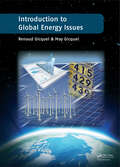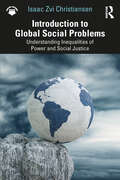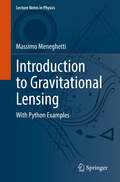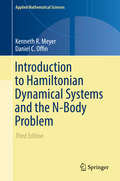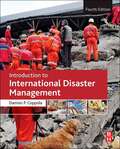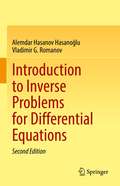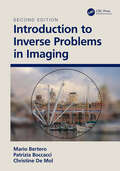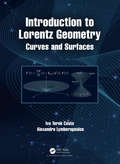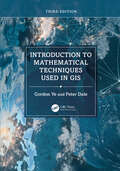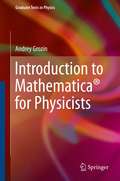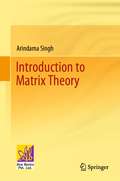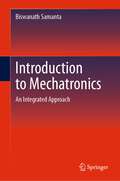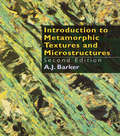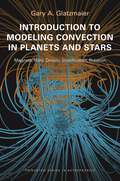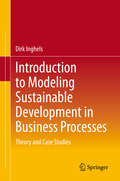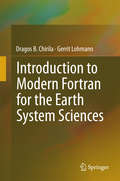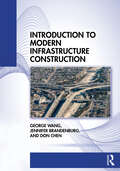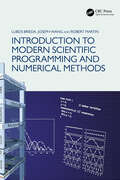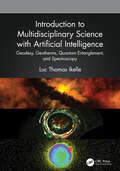- Table View
- List View
Introduction to Global Energy Issues
by Renaud Gicquel May GicquelFrom the discovery of fire to that of the atom, the development of human societies has largely been based on the conquest of energy. In all countries, energy has gradually become one of the key factors of social and economic development, as well as capital, labor and natural resources, and now no one can do without it. After decades of cheap energy
Introduction to Global Social Problems: Understanding Inequalities of Power and Social Justice
by Isaac Zvi ChristiansenIntroduction to Global Social Problems introduces undergraduate students to national and international social problems from a critical sociological perspective. Isaac Zvi Christiansen presents clear descriptions of each social problem, explains key concepts, and provides students with the relevant theoretical tools needed to grasp the interconnected nature of these phenomena.This volume covers significant and interconnected issues. The book begins with an explanation of how corporate interests distort the depiction of social problems. Chapters 2 and 3 provide empirical explorations of poverty and inequality on national and global scales, together with clear and accessible expositions of relevant sociological theories. Chapter 4 examines health and educational inequalities exacerbated by the economic inequalities discussed in Chapters 2 and 3. Chapter 5 introduces students to issues of racial inequalities in the United States and abroad, while Chapter 6 takes a comparative approach to examining crime and criminal justice. Chapter 7 examines modern-day imperialism and war, with special attention given to the military industrial complex, and a brief review of US interventions around the world in the twentieth and twenty-first centuries. Chapter 8 examines politics and human rights, including a critical, historical, and sociological analysis of Israeli settler-colonialism and successive US/Israeli assaults on Gaza. The book closes with an examination of population and the environment, with special attention given to climate change, and the pressing contradictions between capitalism and the environment.This textbook will be a vital resource for introductory students across the social sciences, especially in sociology, political science, and global studies. It provides critical wraparound coverage of the momentous, embedded social problems that interconnect across social, national, and regional boundaries.
Introduction to Gravitational Lensing: With Python Examples (Lecture Notes in Physics #956)
by Massimo MeneghettiThis book introduces the phenomenology of gravitational lensing in an accessible manner and provides a thorough discussion of the related astrophysical applications. It is intended for advanced undergraduates and graduate students who want to start working in this rapidly evolving field. This includes also senior researchers who are interested in ongoing or future surveys and missions such as DES, Euclid, WFIRST, LSST. The reader is guided through many fascinating topics related to gravitational lensing like the structure of our galaxy, the searching for exoplanets, the investigation of dark matter in galaxies and galaxy clusters, and several aspects of cosmology, including dark energy and the cosmic microwave background. The author, who has gained valuable experience as academic teacher, guides the readers towards the comprehension of the theory of gravitational lensing and related observational techniques by using simple codes written in python. This approach, beyond facilitating the understanding of gravitational lensing, is preparatory for learning the python programming language which is gaining large popularity both in academia and in the private sector.
Introduction to Hamiltonian Dynamical Systems and the N-Body Problem
by Kenneth R. Meyer Daniel C. OffinThis third edition text provides expanded material on the restricted three body problem and celestial mechanics. With each chapter containing new content, readers are provided with new material on reduction, orbifolds, and the regularization of the Kepler problem, all of which are provided with applications. The previous editions grew out of graduate level courses in mathematics, engineering, and physics given at several different universities. The courses took students who had some background in differential equations and lead them through a systematic grounding in the theory of Hamiltonian mechanics from a dynamical systems point of view.This text provides a mathematical structure of celestial mechanics ideal for beginners, and will be useful to graduate students and researchers alike. Reviews of the second edition:"The primary subject here is the basic theory of Hamiltonian differential equations studied from the perspective of differential dynamical systems. The N-body problem is used as the primary example of a Hamiltonian system, a touchstone for the theory as the authors develop it. This book is intended to support a first course at the graduate level for mathematics and engineering students. … It is a well-organized and accessible introduction to the subject … . This is an attractive book … ." (William J. Satzer, The Mathematical Association of America, March, 2009) “The second edition of this text infuses new mathematical substance and relevance into an already modern classic … and is sure to excite future generations of readers. … This outstanding book can be used not only as an introductory course at the graduate level in mathematics, but also as course material for engineering graduate students. … it is an elegant and invaluable reference for mathematicians and scientists with an interest in classical and celestial mechanics, astrodynamics, physics, biology, and related fields.” (Marian Gidea, Mathematical Reviews, Issue 2010 d)
Introduction to Hamiltonian Fluid Dynamics and Stability Theory (Monographs And Surveys In Pure And Applied Mathematics Ser. #102)
by Gordon E SwatersHamiltonian fluid dynamics and stability theory work hand-in-hand in a variety of engineering, physics, and physical science fields. Until now, however, no single reference addressed and provided background in both of these closely linked subjects. Introduction to Hamiltonian Fluid Dynamics and Stability Theory does just that-offers a comprehensive introduction to Hamiltonian fluid dynamics and describes aspects of hydrodynamic stability theory within the context of the Hamiltonian formalism.The author uses the example of the nonlinear pendulum-giving a thorough linear and nonlinear stability analysis of its equilibrium solutions-to introduce many of the ideas associated with the mathematical argument required in infinite dimensional Hamiltonian theory needed for fluid mechanics. He examines Andrews' Theorem, derives and develops the Charney-Hasegawa-Mima (CMH) equation, presents an account of the Hamiltonian structure of the Korteweg-de Vries (KdV) equation, and discusses the stability theory associated with the KdV soliton.The book's tutorial approach and plentiful exercises combine with its thorough presentations of both subjects to make Introduction to Hamiltonian Fluid Dynamics and Stability Theory an ideal reference, self-study text, and upper level course book.
Introduction to International Disaster Management
by Damon P. CoppolaIntroduction to International Disaster Management, Fourth Edition, offers an unbiased, global perspective for students and practitioners alike. It provides a comprehensive understanding of the disaster management profession, covering the varied sources of risk and vulnerability, the systems that exist to manage hazard risk, and the many different stakeholders involved, from individuals to global organizations. This text also serves as a reference on scores of disaster management topics, including various technological and intentional hazards, on international disaster management structures and systems, on global humanitarian spending and support, and much more. Taking a real-world approach with considerable illustration through case studies and recent and historical disaster events, this book prepares students interested in joining the disaster management community to understand the work they will be doing. In addition, it assists those who already work with the disaster management community by helping them better navigate this complex environment.
Introduction to Inverse Problems for Differential Equations
by Vladimir G. Romanov Alemdar Hasanov HasanoğluThis book presents a systematic exposition of the main ideas and methods in treating inverse problems for PDEs arising in basic mathematical models, though it makes no claim to being exhaustive. Mathematical models of most physical phenomena are governed by initial and boundary value problems for PDEs, and inverse problems governed by these equations arise naturally in nearly all branches of science and engineering.The book’s content, especially in the Introduction and Part I, is self-contained and is intended to also be accessible for beginning graduate students, whose mathematical background includes only basic courses in advanced calculus, PDEs and functional analysis. Further, the book can be used as the backbone for a lecture course on inverse and ill-posed problems for partial differential equations.In turn, the second part of the book consists of six nearly-independent chapters. The choice of these chapters was motivated by the fact that the inverse coefficient and source problems considered here are based on the basic and commonly used mathematical models governed by PDEs. These chapters describe not only these inverse problems, but also main inversion methods and techniques. Since the most distinctive features of any inverse problems related to PDEs are hidden in the properties of the corresponding solutions to direct problems, special attention is paid to the investigation of these properties.For the second edition, the authors have added two new chapters focusing on real-world applications of inverse problems arising in wave and vibration phenomena. They have also revised the whole text of the first edition.
Introduction to Inverse Problems in Imaging
by M. Bertero P. Boccacci Christine De MolFully updated throughout, with several new chapters, this second edition of Introduction to Inverse Problems in Imaging guides advanced undergraduate and graduate students in physics, computer science, mathematics and engineering through the principles of linear inverse problems, in addition to methods of their approximate solution and their practical applications in imaging. The level of mathematical treatment is kept as low as possible to make the book suitable for a wide range of readers from different backgrounds, with readers needing just a rudimentary understanding of analysis, geometry, linear algebra, probability theory, and Fourier analysis. This second edition contains new chapters on quadratic, iterative, and sparsity-enforcing tikhonov regularizations in addition to maximum likelihood methods and bayesian regularization. The authors concentrate on presenting easily implementable and fast solution algorithms. With examples and exercised throughout, the book will provide the reader with the appropriate background for a clear understanding of the essence of inverse problems (ill-posedness and its cure) and, consequently, for an intelligent assessment of the rapidly growing literature on these problems. Key features: · Provides an accessible introduction to the topic, whilst keeping mathematics to a minimum · Interdisciplinary topic with growing relevance and wide-ranging applications · Accompanied by numerical examples throughout Author bios Mario Bertero is a Professor Emeritus at the Università di Genova. Patrizia Boccacci is a Professor at the Università di Genova. Christine De Mol is a Professor at the Université libre de Bruxelles.
Introduction to Japanese Architecture
by David Young Michiko Young Tan Hong YewIntroduction to Japanese Architecture provides an overview of Japanese architecture in its historical and cultural context. It begins with a discussion of prehistoric dwellings and concludes with a description of contemporary trends in areas as diverse as country inns, underground malls, and love hotels. The intervening 12,000 years are analyzed in reference to major changes in architecture caused by Buddhist and indigenous influences, feudalism, and finally the influence of Western culture in the 19th century.
Introduction to LiDAR Remote Sensing
by Cheng Wang Pinliang Dong Xuebo Yang Xiaohuan Xi Sheng NieLight detection and ranging, or LiDAR, is an advanced active remote sensing technology developed in the last 30 years to measure variable distances to the Earth. This book explains the fundamental concepts of LiDAR technology and its extended spaceborne, airborne, terrestrial, mobile, and unmanned aerial vehicle (UAV) platforms. It addresses the challenges of massive LiDAR data intelligent processing, LiDAR software engineering, and in-depth applications. The theory and algorithms are integrated with multiple applications in a systematic way and with step-by-step instructions. Written for undergraduate and graduate students and practitioners in the field of LiDAR remote sensing, this book is a much-needed comprehensive resource.FEATURES Explains the fundamentals of LiDAR remote sensing, including theory, techniques, methods, and applications Highlights the dissemination and popularization of LiDAR remote sensing technology in the last decade Includes new advances in LiDAR data processing and applications Introduces new technologies such as spaceborne LiDAR and photon-counting LiDAR Provides multiple LiDAR application cases regarding topography mapping, forest investigation, power line inspection, building modeling, automatic driving, crop monitoring, indoor navigation, cultural heritage conservation, and underwater mapping This book is written for graduate and upper-level undergraduate students taking courses in remote sensing, geography, photogrammetric engineering, laser techniques, surveying and mapping, geographic information systems (GIS), forestry, and resources and environmental protection. It is also a comprehensive resource for researchers and scientists interested in learning techniques for collecting LiDAR remote sensing data and processing, analyzing, and managing LiDAR data for applications in forestry, surveying and mapping, cultural relic protection, and digital products.Chapters 1 and 2 of this book are freely available as a downloadable Open Access PDF at http://www.taylorfrancis.com under a Creative Commons Attribution-Non Commercial-No Derivatives (CC-BY-NC-ND) 4.0 license.
Introduction to Lorentz Geometry: Curves and Surfaces
by Ivo Terek Couto Alexandre LymberopoulosLorentz Geometry is a very important intersection between Mathematics and Physics, being the mathematical language of General Relativity. Learning this type of geometry is the first step in properly understanding questions regarding the structure of the universe, such as: What is the shape of the universe? What is a spacetime? What is the relation between gravity and curvature? Why exactly is time treated in a different manner than other spatial dimensions? Introduction to Lorentz Geometry: Curves and Surfaces intends to provide the reader with the minimum mathematical background needed to pursue these very interesting questions, by presenting the classical theory of curves and surfaces in both Euclidean and Lorentzian ambient spaces simultaneously. Features: Over 300 exercises Suitable for senior undergraduates and graduates studying Mathematics and Physics Written in an accessible style without loss of precision or mathematical rigor Solution manual available on www.routledge.com/9780367468644
Introduction to Magnetic Materials, 2nd Edition
by C. D. Graham B. D. CullityIntroduction to Magnetic Materials, 2nd Edition covers the basics of magnetic quantities, magnetic devices, and materials used in practice. While retaining much of the original, this revision now covers SQUID and alternating gradient magnetometers, magnetic force microscope, Kerr effect, amorphous alloys, rare-earth magnets, SI Units alongside cgs units, and other up-to-date topics. In addition, the authors have added an entirely new chapter on information materials. The text presents materials at the practical rather than theoretical level, allowing for a physical, quantitative, measurement-based understanding of magnetism among readers, be they professional engineers or graduate-level students.
Introduction to Mathematical Techniques Used in GIS
by Peter Dale Gordon YeGIS technology and applications have advanced as fast as computing technology to enhance business analytics, predictive modeling, virtual reality, and artificial intelligence. The third edition addresses these new topics of interest to students and practitioners who are using geographic information systems but have a limited mathematical background. Thoroughly updated and reorganized to focus more on applications and problem solving by mathematical techniques, this book explains the basic architecture of computing as it relates to GIS, includes new application examples of selected mathematical methods, and introduces 3D modeling, machine learning, and more.Features Explains the basic mathematics that underpins the manipulation of spatially related data and adds new technology direction such as machine learning. Builds logically step-by-step from simple basic assumptions to real world GIS applications to illustrate mathematical techniques covered in each chapter. Explains computing fundamentals including databases, and modeling techniques such as network modeling and topology overlay. Includes two new chapters focused on how computing relates to mathematics, and new popular applications of GIS which connect with data science and artificial intelligence. Prepares today’s GIS students who do not have STEM backgrounds to follow the thought processes behind the practice of GIS. This textbook is written for those who use global information systems and applications but have a limited mathematical background. It explains the mathematics behind the applications, making it an accessible book for both undergraduate and graduate students in GIS, Computer Science, Geography, and Geomatics.
Introduction to Mathematica® for Physicists
by Andrey GrozinThe basics of computer algebra and the language of Mathematica are described. This title will lead toward an understanding of Mathematica that allows the reader to solve problems in physics, mathematics, and chemistry. Mathematica is the most widely used system for doing mathematical calculations by computer, including symbolic and numeric calculations and graphics. It is used in physics and other branches of science, in mathematics, education and many other areas. Many important results in physics would never be obtained without a wide use of computer algebra.
Introduction to Matrix Theory
by Arindama SinghThis book is designed to serve as a textbook for courses offered to undergraduate and postgraduate students enrolled in Mathematics. Using elementary row operations and Gram-Schmidt orthogonalization as basic tools the text develops characterization of equivalence and similarity, and various factorizations such as rank factorization, OR-factorization, Schurtriangularization, Diagonalization of normal matrices, Jordan decomposition, singular value decomposition, and polar decomposition. Along with Gauss-Jordan elimination for linear systems, it also discusses best approximations and least-squares solutions. The book includes norms on matrices as a means to deal with iterative solutions of linear systems and exponential of a matrix. The topics in the book are dealt with in a lively manner. Each section of the book has exercises to reinforce the concepts, and problems have been added at the end of each chapter. Most of these problems are theoretical, and they do not fit into the running text linearly. The detailed coverage and pedagogical tools make this an ideal textbook for students and researchers enrolled in senior undergraduate and beginning postgraduate mathematics courses.
Introduction to Mechatronics: An Integrated Approach
by Biswanath SamantaThis textbook presents mechatronics through an integrated approach covering instrumentation, circuits and electronics, computer-based data acquisition and analysis, analog and digital signal processing, sensors, actuators, digital logic circuits, microcontroller programming and interfacing. The use of computer programming is emphasized throughout the text, and includes Matlab for system modeling, simulation, and analysis; LabVIEW for data acquisition and signal processing; and C++ for Arduino-based microcontroller programming and interfacing. Prof. Samanta provides numerous examples along with appropriate program codes, for simulation and analysis, that are discussed in detail to illustrate the concepts covered in each section. The book also includes the illustration of theoretical concepts through the virtual simulation platform Tinkercad to provide students virtual lab experience.
Introduction to Metamorphic Textures and Microstructures
by A.J. BarkerA text which aims to help undergraduate students in geology to recognize and interpret metamorphic textures and microstructures in thin-section. For lecturers and postgraduates in geology and petrology, the book provides reference for the interpretation of metamorphic rocks.
Introduction to Modeling Convection in Planets and Stars: Magnetic Field, Density Stratification, Rotation (Princeton Series in Astrophysics #24)
by Gary A. GlatzmaierThis book provides readers with the skills they need to write computer codes that simulate convection, internal gravity waves, and magnetic field generation in the interiors and atmospheres of rotating planets and stars. Using a teaching method perfected in the classroom, Gary Glatzmaier begins by offering a step-by-step guide on how to design codes for simulating nonlinear time-dependent thermal convection in a two-dimensional box using Fourier expansions in the horizontal direction and finite differences in the vertical direction. He then describes how to implement more efficient and accurate numerical methods and more realistic geometries in two and three dimensions. In the third part of the book, Glatzmaier demonstrates how to incorporate more sophisticated physics, including the effects of magnetic field, density stratification, and rotation. Featuring numerous exercises throughout, this is an ideal textbook for students and an essential resource for researchers. Describes how to create codes that simulate the internal dynamics of planets and stars Builds on basic concepts and simple methods Shows how to improve the efficiency and accuracy of the numerical methods Describes more relevant geometries and boundary conditions Demonstrates how to incorporate more sophisticated physics
Introduction to Modeling Sustainable Development in Business Processes: Theory and Case Studies
by Dirk InghelsSustainable development and corporate social responsibility drive countries, regions, and businesses to take environmental and social concerns into account when realizing economic objectives. A growing awareness of the connectedness between industrial, societal, and environmental systems might shift the way businesses will be operated. This book aims to help students and business practitioners use quantitative modeling in their pursuit to make business processes sustainable. Two approaches are introduced: linear optimization and system dynamics. Moreover, the quantification of the three different sustainability objectives is also addressed. Next to introducing the theoretical background, many real-life examples are discussed to demonstrate how the modelling techniques can be applied.
Introduction to Modern Climate Change
by Andrew DesslerThis is an invaluable textbook for any introductory survey course on the science and policy of climate change, for both non-science majors and introductory science students. The second edition has been thoroughly updated to reflect the most recent science from the latest Intergovernmental Panel on Climate Change reports, and many illustrations include new data. The new edition also reflects advances in the political debate over climate change. Unique amongst textbooks on climate change, it combines an introduction to the science with an introduction to economic and policy issues, and is tightly focused on anthropogenic climate change. It contains the necessary quantitative depth for students to properly understand the science of climate change. It supports students in using algebra to understand simple equations and to solve end of chapter problems. Supplementary online resources include a complete set of PowerPoint figures for instructors, solutions to exercises, videos of the author's lectures, and additional computer exercises.
Introduction to Modern Climate Change
by Andrew E. DesslerThis textbook is tightly focused on the problem of anthropogenic climate change. It is unique among textbooks on climate change in that it combines an introduction of the science with an introduction to the non-science issues such as the economic and policy options. Unlike more purely descriptive textbooks, it contains the quantitative depth that is necessary for an adequate understanding of the science of climate change. The goal of the book is for a student to leave the class ready to engage in the public policy debate on this issue. This is an invaluable textbook for any introductory survey course on the science and policy of climate change, for both non-science majors and introductory science students.
Introduction to Modern Fortran for the Earth System Sciences
by Gerrit Lohmann Dragos B. ChirilaThis work provides a short "getting started" guide to Fortran 90/95. The main target audience consists of newcomers to the field of numerical computation within Earth system sciences (students, researchers or scientific programmers). Furthermore, readers accustomed to other programming languages may also benefit from this work, by discovering how some programming techniques they are familiar with map to Fortran 95. The main goal is to enable readers to quickly start using Fortran 95 for writing useful programs. It also introduces a gradual discussion of Input/Output facilities relevant for Earth system sciences, from the simplest ones to the more advanced netCDF library (which has become a de facto standard for handling the massive datasets used within Earth system sciences). While related works already treat these disciplines separately (each often providing much more information than needed by the beginning practitioner), the reader finds in this book a shorter guide which links them. Compared to other books, this work provides a much more compact view of the language, while also placing the language-elements in a more applied setting, by providing examples related to numerical computing and more advanced Input/Output facilities for Earth system sciences. Naturally, the coverage of the programming language is relatively shallow, since many details are skipped. However, many of these details can be learned gradually by the practitioner, after getting an overview and some practice with the language through this book.
Introduction to Modern Infrastructure Construction
by George Wang Don Chen Jennifer BrandenburgIntroduction to Modern Infrastructure Construction serves as a pivotal resource for construction management education, focusing primarily on heavy civil construction and the latest technological innovations in the field. This essential textbook is designed for both academic and professional use, thoroughly covering critical topics including earthwork, highway planning, design, asphalt production, paving, recycling technology, and transportation asset management. Additionally, it explores various aspects of infrastructure such as bridges, railways, airports, and pipelines, offering comprehensive insights beneficial to project management in these areas. Each chapter is supplemented with discussion questions or assignments to enhance educational value, and the text includes lab practice appendices to reinforce practical application.Authored by leading experts in the field George Wang, Jennifer Brandenburg, and Don Chen, Introduction to Modern Infrastructure Construction draws on their extensive experience in academic teaching, research, and practical application. Their expertise provides readers with a unique blend of theoretical knowledge and real-world perspective, making this book an indispensable guide for anyone aspiring to excel in the field of infrastructure construction.
Introduction to Modern Scientific Programming and Numerical Methods
by Joseph Wang Lubos BriedaThe ability to use computers to solve mathematical relationships is a fundamental skill for anyone planning for a career in science or engineering. For this reason, numerical analysis is part of the core curriculum for just about every undergraduate physics and engineering department. But for most physics and engineering students, practical programming is a self-taught process.This book introduces the reader not only to the mathematical foundation but also to the programming paradigms encountered in modern hybrid software-hardware scientific computing. After completing the text, the reader will be well-versed in the use of different numerical techniques, programming languages, and hardware architectures, and will be able to select the appropriate software and hardware tool for their analysis.It can serve as a textbook for undergraduate courses on numerical analysis and scientific computing courses within engineering and physical sciences departments. It will also be a valuable guidebook for researchers with experimental backgrounds interested in working with numerical simulations, or to any new personnel working in scientific computing or data analysis.Key Features: Includes examples of solving numerical problems in multiple programming languages, including MATLAB, Python, Fortran, C++, Arduino, Javascript, and Verilog Provides an introduction to modern high-performance computing technologies including multithreading, distributed computing, GPUs, microcontrollers, FPGAs, and web "cloud computing" Contains an overview of numerical techniques not found in other introductory texts including particle methods, finite volume and finite element methods, Vlasov solvers, and molecular dynamics
Introduction to Multidisciplinary Science with Artificial Intelligence: Geodesy, Geotherms, Quantum Entanglement, and Spectroscopy
by Luc Thomas IkelleThe book is about multidisciplinary science education. The challenges of our time, such as improving the length and quality of lives on Earth and short- and long-distance communication and transportation. In this book, we provide readers with the multidisciplinary education necessary to meet the scientific and technological challenges of our time while optimizing the college experience for students. The fundamental notions addressed in this book include gravitational forces and energy; dark matter and dark energy; heat transfer in solid Earth, stars’ interiors, and human bodies; electromagnetic radiation and spectroscopy; quantum entanglement and computing; accretion disks; matter in plasma state; and exoplanets. We illustrate the importance of these notions with applications across disciplines, including monitoring the deformation of the solid Earth’s surface using satellite measurements, unusual gravity anomalies in Antarctica, a view and characterization of the far side of our Moon, Earth’s climate, Titan’s anti-greenhouse effect, long-distance communication between Earth and the planets and exoplanets, etc. Finally, the book contains analytical and computational problems, including MATLAB software developed especially for the classes associated with this book.Key Features:• Contains multiple analytic and computational (MATLAB) exercises• Explores applications related to space programs' discoveries• Provides an accessible introduction and response to growing Multidisciplinary Science programsDr. Luc Thomas Ikelle is a scientist with Imode Energy. He is also currently an adjunct professor in the Department of Geology and Geophysics at Texas A&M University. Previously, he worked at Cray Research Inc. in Minneapolis, developing 3D seismic inversion algorithms for CRAY Y-PM. From 1988 to 1997, he worked as a scientist for Schlumberger Geco-Prakla, Schlumberger Doll Research, and Schlumberger Cambridge Research. From 1997 to 2014, Dr. Ikelle was Robert R. Berg Professor in the Department of Geology and Geophysics at Texas A&M University. He earned a Ph.D. in geophysics and geochemistry from Paris 7 University in France. He received Le Prix de Thesis du CNRS in 1986 for his Ph.D. thesis, an SEG award in 2010 for his contribution to the creation of Geoscientists Without Borders, and a Texas AM University award as an outstanding scientist in 2012. He is a cofounder of Geoscientists Without Borders and of Imode Energy Research, and a member of SEG, AGU, and APS. Dr. Ikelle has worked as a DOE (US Department of Energy) special employer from 2005 to 2012 and was a member of Ultra-Deepwater Advisory Committee (an advisory committee to the Secretary of Energy) from 2005 to 2012.
